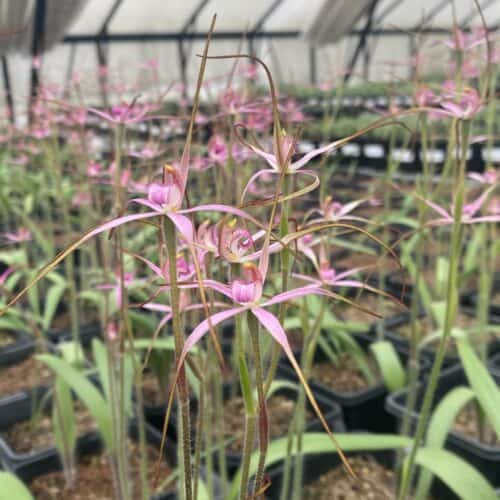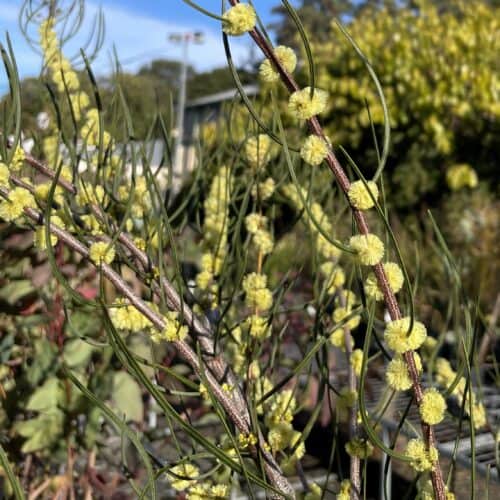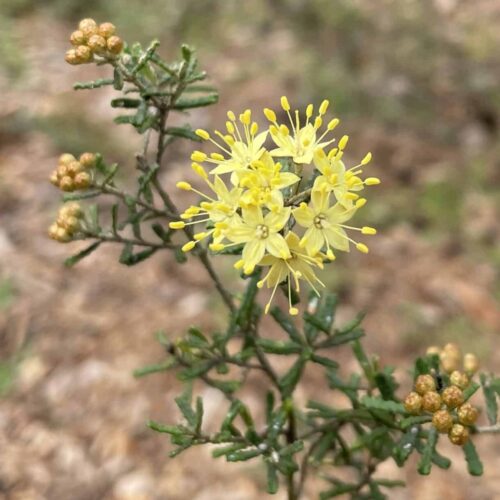Preventing the extinction of Victoria's threatened flora
Background
This project aims to prevent the extinction of 24 endangered or critically endangered Victorian plants. It is focusing on two botanical hotspots, the Gippsland and Grampians regions, as well as threatened flora from the Barwon South West and Port Phillip Regions.
The project is addressing key threatened species recovery actions from 11 threatened species Action Statements and 11 National Recovery Plans and is working to optimise conservation actions across the life cycles of the plants.
The “Preventing the extinction of Victoria’s threatened flora” project will lead to long-term conservation benefits for the 24 plant species, both onsite (in situ) and offsite (ex situ). Ex situ actions include collecting seeds, vegetative plant material, spores, rhizobia and mycorrhiza which will be kept in seed and spore banks, nursery facilities, and raised garden beds at the Royal Botanic Gardens Victoria. These ex situ plant collections will act as long-term insurance populations, as a source of material for future reintroductions, and assist further research.
The project began on 1 June 2023 and will run until the second half of 2026. The ANPC is proud to be collaborating on this project with the Royal Botanic Gardens Victoria, La Trobe University and the other partners listed below.
Activities
This project is following an integrated conservation framework which includes the following activities:
1. Threat assessments, field surveys and community surveys. This includes detailed mapping of populations to establish the number of surviving plants, allowing comparison with past population estimates, and maximising the known plants available for seed collections.
2. Seed and spore collection. For all 24 species, seeds or spores are being collected during the appropriate season, viability tested and stored in a seed/sporebank.
3. Conservation genetics. For 10 species, genetic analysis of wild plants, stored seed or plants currently held in cultivation is informing additional seed collection priorities and ensuring genetic diversity is captured for ex situ collections and future translocations.
4. Germination trials. This includes optimising seed germination techniques for 11 difficult to grow species through germination trials.
5. Pollination studies. Pollinators are being identified at extant in situ sites for 10 species and at potential translocation sites for 9 species. This is assisting with selecting future reintroduction sites based on pollinator presence.
6. Developing permanent ex situ living collections. For 20 species genetically diverse ex situ populations are being established. For 12 species (Orchidaceae and Fabaceae), symbiotic propagation is being undertaken to generate seedlings (using mycorrhizal fungi isolated from the orchids, or rhizobia isolated from the pea plants respectively).
7. Establishing new populations through propagation. For 9 species >200 genetically diverse individuals are being introduced to new sites with their essential symbionts and pollinators present.
8. Workshops. Three one-day workshops on Victorian threatened flora conservation will be held in the Port Phillip, Gippsland and the Grampians (Gariwerd) regions. These are scheduled to be held in 2026.
Project species and threat rating
| Scientific Name | Flora and Fauna Guarantee Act Status | EPBC Act Status |
| Acacia phasmoides | CR | VU |
| Adiantum diaphanum | CR | |
| Caladenia ancylosa | CR | |
| Caladenia rosella | CR | CR |
| Caladenia valida | CR | |
| Craspedia canens | CR | |
| Daviesia laevis | CR | EN |
| Diuris ochroma | EN | VU |
| Grevillea microstegia | CR | |
| Grevillea pachylostyla | CR | |
| Grevillea parvula | EN | |
| Isoetes pusilla | EN | |
| Phebalium glandulosum subsp. macrocalyx | CR | |
| Pimelea pagophila | EN | EN |
| Prostanthera galbraithiae | EN | VU |
| Prostanthera walteri | EN | |
| Pterostylis basaltica | CR | EN |
| Sphaerolobium acanthos | CR | CR |
| Spyridium furculentum | CR | EN |
| Swainsona plagiotropis | EN | VU |
| Swainsona reticulata | EN | |
| Swainsona sericea | EN | |
| Thelymitra mackibbinii | CR | VU |
| Xerochrysum palustre | CR | VU |
CR – critically endangered, EN – endangered, VU – vulnerable
Project partners
This project is funded by @deeca_vic’s / @DEECAVictoria’s Nature Fund. The ‘Preventing the extinction of Victoria’s threatened flora’ project is led by the Royal Botanic Gardens Victoria in partnership with La Trobe University, Australian Network for Plant Conservation, DEECA, Parks Victoria, Trust for Nature, Wimmera Catchment Management Authority, Nillumbik Shire, ENVITE, Bairnsdale & District Field Naturalists Club, Friends of the Grampians Gariwerd, WAMA Botanic Gardens, Halls Gap Botanic Gardens, and the Australasian Native Orchid Society Victorian Branch.
Project contacts
Dr Noushka Reiter – Senior Research Scientist (Conservation)
Dr Ryan Phillips – Senior Lecturer in Conservation Biology (La Trobe University)
Dr Linda Riquelme – Post-doctoral Fellow (La Trobe University)
Dr Andre Messina – Botanist
Dr Rebeca Miller – Seed Research Scientist
Dr Meg Hirst – Seed Ecologist
Dr Hong Zhang – Technical Assistant (Seedbank)
Dr Daniel Ohlsen – Botanist
Dr Elizabeth James – Senior Research Scientist (Genetics)
Dr Tara Hopley – Research Scientist (Genetics)
Dr Laura Simmons – Post-Research Scientist (Genetics)
Alex Mclachlan – Research Assistant
John Woodward – Technical Assistant
Rebecca Grinter – Masters student (La Trobe University)
Eamonn Culhane – Honours student (La Trobe University)
Dr Alastair Robinson – Manager (Biodiversity Services)
David Robbins – Team Leader (Nursery Melbourne)
Chris Jenek – Horticulturist (Nursery Melbourne)
Nicoletta Centofanti – Horticulturist (Nursery Melbourne)
Russell Larke – Senior Curator (RBGV Cranbourne)
Mandy Thomson – Team Leader Nursery (RBGV Cranbourne)
Jo Lynch – Business Manager (ANPC)
Richie Southerton – Communications Manager (ANPC)
Funding Acknowledgement
This project is funded by the Victorian Government Department of Energy, Environment and Climate Action (DEECA) Nature Fund, and project partners.


Caladenia rosella – Credit: Dr Noushka Reiter

Acacia phasmoides – Credit: Dr. Andre Messina

Phebalium glandulosum subsp. macrocalyx: Credit – Dr. Andre Messina

